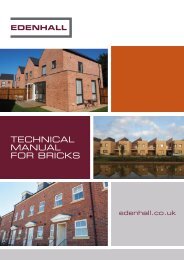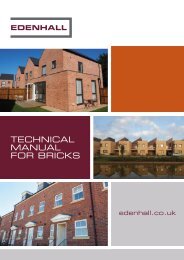Create successful ePaper yourself
Turn your PDF publications into a flip-book with our unique Google optimized e-Paper software.
BTB 5<br />
CONCRETE TECHNOLOGY<br />
When concrete dries out it contracts and shrinks. When it is extracted from the mould in its uncured state it is as large as it is ever going<br />
to be but as it cures it shrinks but expands again when wetted. That expansion does not occur to the same extent as the shrinkage.<br />
These volume changes due to variations in moisture content are an inherent characteristic of hydraulic cement based concretes. The<br />
volume and type of aggregate and cement content have a significant effect on the magnitude of these volume changes. Since <strong>Edenhall</strong><br />
bricks are produced with a relatively low cement content and use low shrinkage aggregates the volume changes are low.<br />
The requirement within BS EN 771-3, “Specification for Concrete Masonry Units”, sets no limits for shrinkage or moisture movement<br />
and the values for <strong>Edenhall</strong> bricks can be found with the individual CE and DoP documents. Designers should take into accounts these<br />
values when comparing against other concrete masonry materials. However independent tests carried out on <strong>Edenhall</strong> bricks show a<br />
typical Facing Brick to have the following values:<br />
Drying Shrinkage: 0.07 – 0.17 mean 0.12mm/linear metre<br />
Moisture Movement: 0.12 – 0.17 mean 0.14mm/linear metre<br />
Total Movement Coefficient:<br />
0.26mm/linear metre<br />
Note: The test method measures the moisture expansion between the bricks at initial ambient condition and after soaking in water<br />
for four days and then the shrinkage between that saturated value and after drying for 21 days @ 33°C. The sum of these gives the<br />
total movement coefficient. These are extreme conditions – in effect measuring from absolute saturation to complete oven dry – a<br />
condition unlikely to occur in practice on site. Indeed research in Canada estimates that actual shrinkage and moisture movement<br />
is probably only half that compared with a standard test. It should also be noted that the effects of shrinkage due to drying may be<br />
compensated for by the thermal expansion due to solar effects.<br />
DESIGN CONSIDERATIONS<br />
Types of Movement:<br />
Movement in a structure can arise from the effects of:<br />
• Thermal influences<br />
• Shrinkage and moisture movement characteristics of the external masonry<br />
• Changes in the orientation or shape of a building<br />
• Site practice<br />
• Type and grade of mortar<br />
The tendency for all concrete products is to shrink slightly over time and when drying out, although they may revert back to near their<br />
original size when subject to moisture. Like all materials they are also subject to thermal movement. Consequently the location of<br />
movement joints is to define the most appropriate position to accommodate this movement whilst considering the aesthetic, practical<br />
and structural factors.<br />
Mortar Choice:<br />
The recommended movement joint spacing of between 7.5-9 metres assumes the use of a Type iii (compressive strength M4) mortar, ie.<br />
1:1:6 or equivalent. It should be noted that mortars designated by strength may be stronger than those batched by volume due to the<br />
statistical requirement to achieve the minimum strength.<br />
Stronger mortars, such as M6, which have higher shrinkage values, may necessitate the reduction in spacing of joints down to 6 metres.<br />
Lime based mortars, with their degree of flexibility to accommodate movement, offer better characteristics than pure sand/cement<br />
based mortars. For further information on Mortar Selection see <strong>Technical</strong> Bulletin BTB 4.<br />
Site Protection:<br />
Since bricks shrink slightly as they dry out it is important that they are kept as dry as possible before laying. Opened packs should be<br />
covered up, as should bricks after they have been stacked up around the site. Incomplete brickwork should be protected as this will<br />
minimise the risk of shrinkage and efflorescence leaching from around the mortar joints.<br />
Thermal Movement:<br />
South facing walls, particularly those built of dark coloured bricks, are more susceptible to thermal movement than other elevations.<br />
Whereas a simple contraction joint may suffice in more sheltered elevations, joints for southern facing elevations should have movement<br />
joints which are capable of responding to both expansion and contraction. If movement joints are not practical in these elevations then<br />
the use of bed joint reinforcement should be considered above and below large openings.







